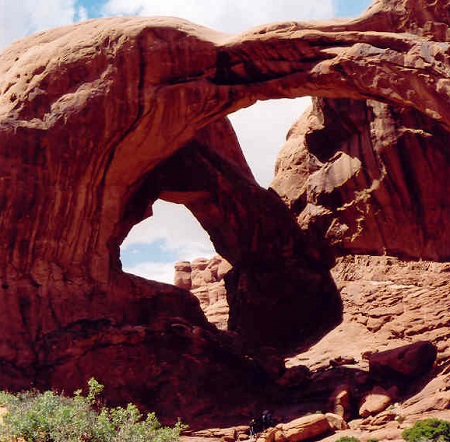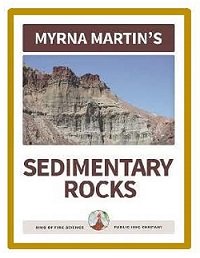What are Clastic Rocks?
New rocks made of older rocks
Clastic rocks
Clastic rocks are the broken bits and pieces of older rocks that lithified (turn to stone) and became new rocks. The broken bits and pieces of older rocks are clasts. Clasts can be as tiny as the dust on the sill of a window or large boulders.
Composition of clastic rocks
Clastic rocks consist chiefly of quartz, feldspars, rock
fragments, micas, clay minerals, iron oxides, and calcite. Other clasts result
from chemical alteration of the minerals during chemical weathering.
Sedimentary layers in the oceans
Large quantities of sediments are carried into oceans by rivers
each day. The particles settle out and form sedimentary layers on continental
shelves. The sediments settle at different speeds depending of the size of the
particles. The largest particles settle out of the water first. These sediments
are usually sand size particles that create sandy beaches as they accumulate on
the seashore.

Double Arch a sandstone formation Trish White
Four Major groups of clastic rocks
What are the four major groups of clastic rocks?
Gravel, sand, silt, and clay are the four major groups of
clasts based on their size. Gravel is broken into three subgroups because of
the large variation in the size of the clasts. Boulder gravel is the largest,
cobble gravel is medium size, and pebble gravel is the smallest.
Difference between silt and clay
You can tell if a rock is silt or clay by feeling the
surface of the rock. If it feels gritty to the touch it is siltstone. If the
rock feels smooth to the touch it is a clay rock.
Sandstone and greywacke
Sandstone and greywacke are both made of sand-size
clasts that are cemented together. Light colored sandstone is predominantly
quartz. Greywacke is a dark-colored sandstone that contains quartz, feldspar,
and tiny rock fragments.
Sandstone rock formation
Sandstone rocks
Sandstone is created when sand-sized particles of rocks are cemented together. The most abundant mineral found in sandstone is quartz. Running water and wind carry grains of quartz into areas of large sedimentary beds. The sedimentary beds eventually turn into sandstone.
Shale forms on offshore seafloors
Formation shale rocks
Shale rocks are created when microscopic pieces of weathered rock are cemented together. Layers of silt and clay are carried into the oceans by floodwater. The individual particles are so light they settle offshore on the ocean floor. The lighter and smaller the particles the further they drift in the ocean before settling on the ocean floor. Shale and mudstone are two examples of rocks created from silt and clay.


Click for More Information and to Order
Conglomerates and Breccia
Conglomerates
Conglomerate rocks contain small rounded rocks. The pebbles are larger than the size of gravel and they have been cemented together. Sand-size or smaller clasts are cemented between the pebbles and gravel. The small rocks in the conglomerates have rounded edges.
Breccia
Breccia rocks form from clasts that have sharp edges. The clasts have not been rounded off in streams like conglomerate rocks. They are often found in fault zones where the rocks broke off older rocks during movement along the fault line.
KIDS FUN Science Bookstore
Check out Myrna Martin's award winning textbooks, e-books, videos and rock sets. The Kids Fun Science Bookstore covers a wide range of earth science topics. Click here to browse.










